
| |
Yacht Seabird Circumnavigation
Saturday, March 04, 2006
How it all Started - Statesville, NC
Until my late twenties, my life went like this.
Boats, horses, something else, boats, horses, something else, boats, horses...
There was the jockey phase, the Alfa Romeo mechanic phase, the Tuscan linguist phase and then at age twenty-five I went back to NC State University, got my degree and a few years later started the phase most folks had a head start on.
The office phase.
I worked with a German wood-working machinery company for a while and it was a swell job. They sent me to meetings in a plane and put me up in hotels and put me in charge of training their sales agents. It was a fine job, really. And I'll be forever gratefull they took me on.
Part of my job was editing photos of cutterheads on the computer. To save time, I learned that I could undo my mistakes by hitting the "Control" and "Z" key at the same time.
I was getting pretty good at this. Mistake, twitch of the finger, mistake gone.
Then one day I spilled a cup of coffee and my fingers twitched for the imaginary keys that weren't there.
"Oh God! I'm thinking like the machine!" shot through my head. If this was my future, I decided there on the spot, I'd better start living another life.
So I put in my notice, trained my replacement, and cashed in my Roth account. It yielded 500 dollars. But that was enough.
Boats, horses, something else, my life had gone.
I'd just finished a "something else" phase so it seemed natural I jump back to the boat phase.
I took what little money I had and put it toward getting Sea Bird sea worthy.
Bernie
RiverEarth.com
posted
by Bernie at 7:24 PM
Thursday, March 02, 2006
65 Days Alone at Sea - St John Island, US Virgin Islands
On February 17, 2003, Sea Bird sailed from Cape Town, South Africa, for the Virgin Islands. For 31 days she roared before the Southeast Trades, scattering the flying fish with such vigor that only the streaming clouds proved fleet enough to catch her. Then Bang! On day 32 she crashed headlong into the Doldrums. From one day to the next, the wind just tumbled from the sky. The sun, possessor of the static blue, rejoiced.
Sea Bird, of course, skidded to a halt.
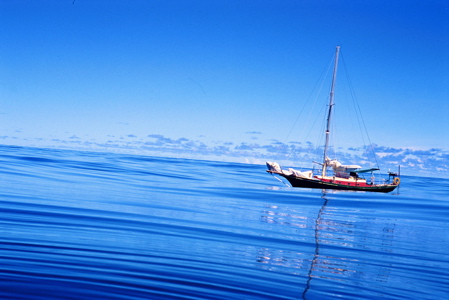
The sea, from marching us home with six-foot waves, took to shimmering smugly, hot and calm as fresh tarred runway. It was time to swap record-breaking notions for thoughts of killing time.
Catching up on world news was out. I travel with no long distance communications, carry no high frequency radio. So I set to drying the last Granny Smiths before they rolled themselves to applemush in the pulsing windless swell.
It was pleasurable work, quartering the apples; running the sail-needle through half moon pieces; hanging the fruit garlands from Sea Bird's weather shrouds. I worked slowly and peacefully in the shade of the cockpit awning, as though the wind were watching and might reward my patience with a gust in the homeward direction.
But no, the breeze stayed put.
Next, I read War and Peace. The days piled up. The strung and quartered apples, now potato chip sized, swung in rhythm over heat-stroked seas. After a week, a school of match-sized blue and yellow fish showed up in the shade of the hull. But nothing, not the shriveling apples, not the milling fish, not even the thousand small-print pages, could stir a zephyr.
Then came the day the weight of waiting struck; suddenly the sea appeared hard enough to walk on. All I needed was the ice-walker's faith that the waters would hold. "Step on out" the South Atlantic beckoned. "I'll hold you up".
That's the day I stepped overboard.
I guess if I'd blindly heeded the call it would have been the trip's climax soaking. Instead, I launched Sea Bird's punt and stepped into that, contenting myself with a bit of plywood between myself and the eternal sea floor, 12,000 feet below.
With the seven-foot dink afloat and me safely in it, I began rowing. The pancake sea, flattened from days of inactivity, seemed greased, and between strokes the small craft just carried on of its own accord, like gliding on ice. The spell of empty waters was upon me. Pulling and pulling and pulling on the looms, I rowed until all I could see was the abandoned Sea Bird's mast, sandwiched between the shimmering sea and the sky. Then I rowed some more.
In time I shipped the oars and coasted to a halt, a thousand miles from African shores. The last drop of water fell from oar blade into ocean, splashing mute as into cotton. I was hung between sea and sky; suspended among blue shafts of sunlight that bored the inky abyss. Now this was alone.
Or was I alone? Deep down, weaving in and out of the submerged sunbeams, I could make out tiny fish shapes. As they wriggled toward me I recognized their profiles; they were the blue and yellow fish drawn to Sea Bird's shade. They'd tagged along beneath my skiff, looking to rid themselves of a mutual cabin fever. From the excited way they swam, I could see they considered this a grand outing. After I sat and watched them a spell, they began darting to the surface, apparently in pursuit.
What where they after? Peering closer, I saw tiny, lint-sized water striders, those aquatic insects that, like their larger farm pond cousins, scull the waters like spastic Olympic rowers. These fellows skittered and tacked the waters around my skiff, dashing and skipping away from the charging fish as needed. When the chase got too hot, they'd spring from the water and cling to the dinghy's topsides, leaving the fish below frantic and snapping at their heels.
I had to smile. Here I was, just starting to feel dizzy and alone in the cosmic brine. And then these tiny fragile characters popped out of seemingly empty ocean to keep me company. I don't know how long I sat there but it was a pleasurable while, just sitting out there on the mirage of sea, watching the fish and bugs.
That night the Northeast Trades blew in and sent us on our way. Lying in my sea berth among the rushing waves, I wondered where my friends were sleeping. The sea turned rough and I never saw them again.
On April 23, I landed in St. John, Virgin Islands after 65 days alone and shut off from the outside world. Within my first wobbly steps ashore, I'd hugged an unknown lady until I fear her eyes bulged. Fish as mates are great but only go so far.
posted
by Bernie at 4:12 PM
Wednesday, January 11, 2006
A Few Words on Steel
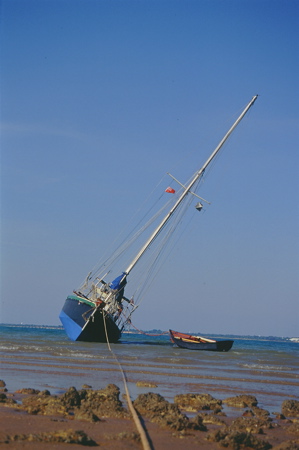
Why Bernie likes steel:
Sea Bird hard aground (and yes those are rocks in the foreground...)
Australia 2002
Steel, I've discovered by scrapes, bangs, and crashes, is just great worldwide cruising insurance. I didn't carry an insurance policy as such. Too expensive... My insurance policy was Sea Bird's steel hull.
For starters, I like steel just because it's so dang strong.
Want to do a bottom job without hauling her out? If you have enough tide, just lean her against a sea wall, or even just on her side, and get going. Forget about propping the bow and hull with jack stands like on a wooden boat. Just lash her down tight and get scraping and painting.
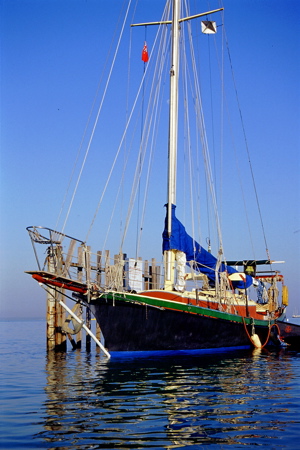
Sea Bird lashed alongside the drying grid in preparation for antifouling
Australia 2002
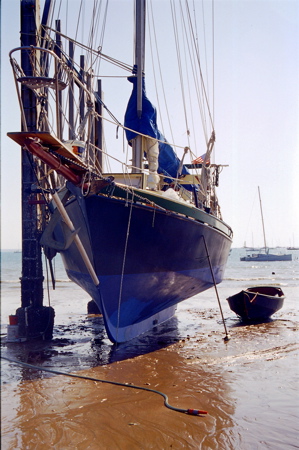
The tide's out now. Time to get painting.
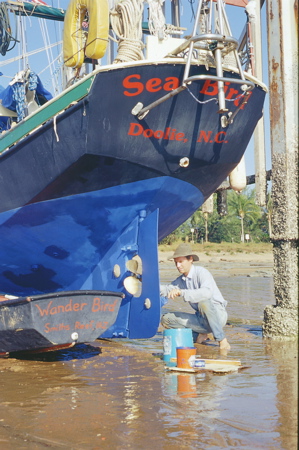
The final touches before the tide refloats her.
Sure, you can do this with a wood or fiberglass hull, too. But nothing reassures me like steel when the hull starts banging up and down on the rocky bottom as the tide refloats you.
Now think of this.
Pile your steel boat on a reef (like my buddy Bill did) and you stand a better chance than any other material. Bill banged 5 days across South Bellona reef; then sailed away. Get hit by the Customs boat ('happened to me in Cocos Keeling) and you get apologies, not sunk.
Steel hulls are good log and lightening protection. And besides, they show up well on radar, a nice thought to ponder as you doze off on passage.
But any discussion about steel boats isn't complete without the mention of the "r" word.
Rust.
But remember. Any discussion of fiberglass brings up the dreaded "Osmosis" word. And wood hulls bring "Rot" to mind. And aluminum cries "Electrolysis" and ferrocement says "Keep Away from Reefs". But we still all go boating don't we?
On Sea Bird, I controlled rust in three ways.
First, Sea Bird's hull was sandblasted and hot zinc sprayed when it was built. That initial application of molten zinc means the hull was virtually galvanized before it ever saw paint. This blasted-on layer of zinc offers a protective barrier on top of the raw steel; sort of a super primer coat for the subsequent two-part paints. That's a major head start.
Second, I rely on a thick application of modern epoxy paints. Remember, on a steel boat it's not so much how many coats of paint you slap on but how thickly you apply them. People often apply half a dozen thinned-down coats to their steel hull, trying to save a buck. They're kidding themselves when they think "Well good, I put on the six coats just like it said on the can". Then their skimpy paint jobs let them down because they were too thin.
If you're protecting steel from long-term saltwater exposure, think thick. That takes lots of paint.
And the only paint to use?
Two-part epoxy.
Don't even think of using one part oil enamels. I did. Once. And I ended up having to sand it all off. You might get away with it on your steel boat if all you want to do is sit in the marina and tell everyone your going to sail for the Marquessas in the spring. But if you're really going to visit Nuka Hiva,you'll need real rust protection. By that I mean a paint job that'll take months of offshore sailing.
So you can only go epoxy and thick.
Which means money! And that's why ultimately so many people cheap out on their paint job and end up with rust blossoms crying down their steel hulls.
Most knowledgeable paint reps familiar with steel boats recommend a 250 to 300 micron paint film thickness.
Minimum.
And that's not just becuase they want to sell paint. Steel needs that thick of a physical barrier.
In New Zealand I repainted Sea Bird to an overall film thickness approaching 500 microns in exposed areas. The Kansai paint rep came out from time to time with his paint thickness meter to ensure all areas got enough coverage. I went through over thirty gallons of paint. Then I sailed 18,000 offshore miles with nary a peep of rust.
I know.
Some people say "Well epoxy's fine but it's not shiny." Fine. If you want a shiny paint job, overcoat it with a two part polyurethane. But really, if you have a steel boat, remember why you have it. You bought that big clanky sucker so you won't sink and you can lean up against pilings and not have to worry about the perfect paint job.
Still, I sound cavalier but pride myself in Sea Bird's final finish. She fools people because her cabin and topsides are so clean, rust free. It still cracks me up when people motor over to ask "Wow, what a pretty boat. She's wood, right?" And I have them rap their knuckles on the hull, and it goes BOING! and they jump back in surprise.
The third way keep a steel hull is to keep it well ventilated.
Inside.
To that end, I lined Sea Bird's hull with varnished kauri battens. (Kauri is New Zealand's premeir boatbuilding wood. Well, it was until it became protected. Now karui can only be harvested with special permits. I got lucky. My kauri's well over a thousand years old). With battens in place, all lockers and storage have a one-inch air gap between their contents and the hull. This keeps everything away from the hull plating and allows fresh air to circulate behind all your belongings. Clothes don't wad up against the sides and the canned peaches don't chip the paint off the hull.
In addition, I added vent holes to aerate all lockers, compartments and closed areas. Again, this circulates air through the entire length of the boat. Fresh air flows from the bow through the forward chain locker through the clothes lockers. Then it goes through the hanging locker right on back to the cabin storage and the engine room. That way the whole boat breathes.
It all adds up to fresh-from-the-laundry-smelling shirts. And no rust. And possibly a floating boat the day you pile onto that log, container, wreck or reef.
So there you have it. My thoughts on steel.
It's what got me around.
Bernie
RiverEarth.com
posted
by Bernie at 11:47 PM
| |

